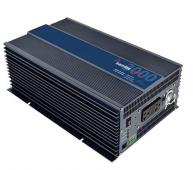chrisski
Solar Boondocker
- Joined
- Aug 14, 2020
- Messages
- 5,398
Which specific switch do you recommend and which specific inverter that will not spark? I don't care about the technical math or to go to deep. Just what you use that is working for you.DC switching-- normally switching DC ''on'' is easy. Switching it off is a problem because all circuits have inductance of some type including wire. That is something that should be corrected in the units design phase. Current in an inductor cannot be changed instantly. This is getting too technical, I will end getting deeper into into the tech other than to share V = L(di/dt). This basic equation shows how a huge voltage will develop if the current is stopped with t = 0 such as opening a switch.
Here are two quality devices I use together that still spark:
1) Blue Sea 350 amp switch:
e-Series - Blue Sea Systems
350 Amps continuous rating for inboard gasoline or diesel engines.

2) Samalex 3000 PST - 24
3000 Watt 24V Power Inverter | PST-3000-24 | Samlex America
Industrial Grade 3000W 24V DC-AC Pure Sine Wave Power Inverter. Converts 24VDC to 120VAC. Robust, heavy-duty power for tools, appliances and electronics.
 samlexamerica.com
samlexamerica.com

I do think @Hedges is correct on this. I have a Lithium Battery bank for the 3000 watt inverter. The Battery on / off switch pictured above melted away some of the copper on the switch when the battery was turned on and off and created a spark I coudl see through the plastic on the blue sea switch.Inductive kick isn't the issue here. It is low internal resistance of lithium batteries.
Last edited:






